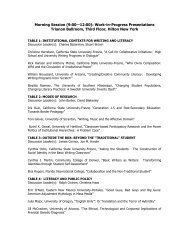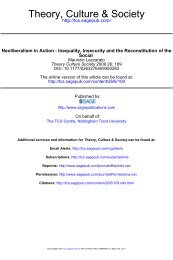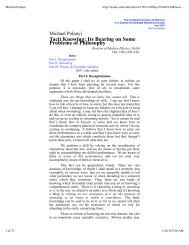PUBLIC OPINION by WALTER LIPPMANN TO FAYE LIPPMANN ...
PUBLIC OPINION by WALTER LIPPMANN TO FAYE LIPPMANN ...
PUBLIC OPINION by WALTER LIPPMANN TO FAYE LIPPMANN ...
You also want an ePaper? Increase the reach of your titles
YUMPU automatically turns print PDFs into web optimized ePapers that Google loves.
_Cf._ also his comment on _Dante's Visual Images, and his Early<br />
Illustrators_ in _The Study and Criticism of Italian Art_ (First<br />
Series), p. 13. "_We_ cannot help dressing Virgil as a Roman,<br />
and giving him a 'classical profile' and 'statuesque carriage,' but<br />
Dante's visual image of Virgil was probably no less mediaeval, no<br />
more based on a critical reconstruction of antiquity, than his entire<br />
conception of the Roman poet. Fourteenth Century illustrators make<br />
Virgil look like a mediaeval scholar, dressed in cap and gown, and<br />
there is no reason why Dante's visual image of him should have been<br />
other than this."] He goes on to show how in regard to the human<br />
figure we have been taught to see what we do see. "Created <strong>by</strong><br />
Donatello and Masaccio, and sanctioned <strong>by</strong> the Humanists, the new canon<br />
of the human figure, the new cast of features ... presented to the<br />
ruling classes of that time the type of human being most likely to win<br />
the day in the combat of human forces... Who had the power to break<br />
through this new standard of vision and, out of the chaos of things,<br />
to select shapes more definitely expressive of reality than those<br />
fixed <strong>by</strong> men of genius? No one had such power. People had perforce to<br />
see things in that way and in no other, and to see only the shapes<br />
depicted, to love only the ideals presented...." [Footnote: _The<br />
Central Italian Painters_, pp. 66-67.]<br />
2<br />
If we cannot fully understand the acts of other people, until we know<br />
what they think they know, then in order to do justice we have to<br />
appraise not only the information which has been at their disposal,<br />
but the minds through which they have filtered it. For the accepted<br />
types, the current patterns, the standard versions, intercept<br />
information on its way to consciousness. Americanization, for example,<br />
is superficially at least the substitution of American for European<br />
stereotypes. Thus the peasant who might see his landlord as if he were<br />
the lord of the manor, his employer as he saw the local magnate, is<br />
taught <strong>by</strong> Americanization to see the landlord and employer according<br />
to American standards. This constitutes a change of mind, which is, in<br />
effect, when the inoculation succeeds, a change of vision. His eye<br />
sees differently. One kindly gentlewoman has confessed that the<br />
stereotypes are of such overweening importance, that when hers are not<br />
indulged, she at least is unable to accept the brotherhood of man and<br />
the fatherhood of God: "we are strangely affected <strong>by</strong> the clothes we<br />
wear. Garments create a mental and social atmosphere. What can be<br />
hoped for the Americanism of a man who insists on employing a London<br />
tailor? One's very food affects his Americanism. What kind of American<br />
consciousness can grow in the atmosphere of sauerkraut and Limburger<br />
cheese? Or what can you expect of the Americanism of the man whose<br />
breath always reeks of garlic?" [Footnote: Cited <strong>by</strong> Mr. Edward Hale<br />
Bierstadt, _New Republic_, June 1 1921 p. 21.]





